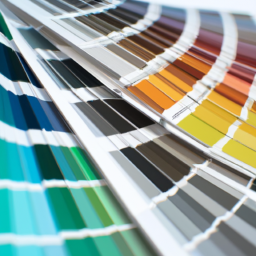
Are you looking to bring the beauty of the outdoors into your home? If so, you’re in the right place. In this blog post, we’ll explore the fascinating world of nature-inspired color palettes for interior design. Whether you’re a fan of earthy tones or vibrant hues, incorporating natural colors into your living space can create a serene and harmonious atmosphere. So, let’s dive in and discover how you can infuse your home with the captivating colors of nature.
The Influence of Nature-Inspired Color Palettes in Interior Design
When it comes to designing the interior of your home, one of the most important aspects to consider is the color palette. Colors have the power to influence our emotions, set the mood, and create a harmonious atmosphere. Nature-inspired color palettes, in particular, have gained popularity in recent years for their ability to bring a sense of tranquility and serenity into our living spaces. In this article, we will explore the influence of nature-inspired color palettes in interior design and provide you with a step-by-step guide on how to incorporate these palettes into your own home.
The Psychology of Colors in Interior Design
Before we delve into nature-inspired color palettes, it is important to understand the psychology behind colors in interior design. Colors evoke different emotions and can greatly impact our well-being. For instance, warm colors like red, orange, and yellow tend to energize and create a sense of warmth and coziness. On the other hand, cool colors like blue, green, and purple have a calming effect and can promote relaxation and tranquility.
When it comes to nature-inspired color palettes, the colors found in the natural world are often associated with specific emotions and moods. For example, shades of green are often linked to feelings of freshness, renewal, and harmony, while blues can evoke a sense of calmness, stability, and serenity. By incorporating these colors into your interior design, you can create a space that not only looks beautiful but also promotes a sense of well-being.
Now that we understand the psychology behind colors, let’s explore some nature-inspired color palettes that you can incorporate into your interior design:
1. Earthy Tones Palette
The earthy tones palette is inspired by the colors found in nature, such as browns, beiges, and warm neutrals. These colors are reminiscent of the earth, sand, and stones, and can create a cozy and grounding atmosphere in your home. To incorporate this palette into your interior design, consider using warm beige or taupe for your walls, and complement them with rich brown furniture and accents. Add pops of green with indoor plants to bring a touch of nature indoors.
2. Coastal Palette
The coastal palette is inspired by the colors of the ocean, beach, and sky. It features shades of blue, turquoise, sandy beige, and crisp white. This palette is perfect for creating a serene and relaxing atmosphere in your home. To incorporate the coastal palette, use light blue or turquoise for your walls, and pair them with white furniture and accessories. Add natural textures like rattan or jute to complete the coastal look.
3. Forest Palette
The forest palette is inspired by the colors of lush green forests. It features shades of green, brown, and muted earth tones. This palette can create a sense of tranquility and connection with nature. To incorporate the forest palette, use deep green or olive for your walls, and pair them with brown furniture and natural wood accents. Add pops of color with botanical prints or fresh flowers to bring the forest indoors.
Conclusion
Nature-inspired color palettes have a powerful influence on our emotions and can greatly impact the atmosphere of our living spaces. By incorporating earthy tones, coastal colors, or forest hues into your interior design, you can create a harmonious and tranquil home. Remember to choose colors that resonate with you and evoke the emotions and moods you desire. Experiment with different palettes and have fun creating a space that truly reflects your connection with nature.

Exploring the Benefits of Using Nature-Inspired Color Palettes in Interior Design
When it comes to interior design, color plays a crucial role in setting the mood and creating a harmonious atmosphere. One popular trend that has gained traction in recent years is the use of nature-inspired color palettes. Drawing inspiration from the natural world, these color schemes bring a sense of tranquility, balance, and connection to the outdoors into our living spaces. In this article, we will delve into the benefits of using nature-inspired color palettes in interior design and provide you with a step-by-step guide on how to incorporate them into your own home.
Creating a Calming and Serene Environment
Nature-inspired color palettes are known for their ability to create a calming and serene environment. By using colors that mimic the hues found in the natural world, such as soft greens, earthy browns, and soothing blues, you can instantly transform a space into a tranquil oasis. These colors have a soothing effect on the mind and help to reduce stress and anxiety, making them perfect for bedrooms, living rooms, and relaxation areas.
When selecting colors for your nature-inspired palette, consider the emotions and feelings you want to evoke in each room. For example, if you want a bedroom that promotes restful sleep, opt for cool, muted tones like sage green or lavender. If you’re looking to create a cozy and inviting living room, warm earthy tones like terracotta or sandy beige can do the trick.
In addition to the colors themselves, the use of natural materials and textures can further enhance the calming effect of a nature-inspired color palette. Incorporate elements like wooden furniture, stone accents, and organic textiles to create a space that feels grounded and connected to the earth.
Bringing the Outdoors In
One of the greatest benefits of using nature-inspired color palettes is the ability to bring the outdoors in. By incorporating the colors of nature into your interior design, you can create a seamless transition between your indoor and outdoor spaces, blurring the boundaries and creating a sense of harmony.
To achieve this, consider the natural surroundings of your home. Take inspiration from the colors of the landscape, whether it’s the lush greens of a forest, the warm earth tones of a desert, or the cool blues of a coastal area. By mirroring these colors in your interior design, you can create a cohesive and inviting space that feels connected to its surroundings.
Another way to bring the outdoors in is by incorporating natural elements and motifs into your decor. Consider adding potted plants, botanical prints, or nature-inspired artwork to infuse your space with a touch of the natural world. These subtle touches can make a big impact and create a sense of tranquility and serenity.
Enhancing Well-being and Productivity
Colors have a profound impact on our emotions and well-being. By using nature-inspired color palettes in your interior design, you can enhance your overall sense of well-being and boost productivity in your home.
Studies have shown that exposure to nature and natural colors can have a positive effect on our mental health. Greens, in particular, have been found to promote feelings of relaxation and rejuvenation. Incorporating shades of green into your workspace or home office can help improve focus, creativity, and productivity.
When choosing colors for different areas of your home, consider the activities that will take place in each space. For example, if you have a home gym or exercise area, energizing colors like vibrant oranges or deep reds can help boost motivation and energy levels. On the other hand, if you have a reading nook or a meditation space, softer colors like pale blues or lavender can create a sense of calm and tranquility.
In conclusion, nature-inspired color palettes offer numerous benefits when it comes to interior design. From creating a calming and serene environment to bringing the outdoors in and enhancing well-being and productivity, these color schemes have the power to transform your living spaces. By following the step-by-step guide provided in this article, you can easily incorporate nature-inspired colors into your own home and enjoy the many benefits they have to offer.

How to Incorporate Nature-Inspired Color Palettes into Your Interior Design Scheme
When it comes to interior design, finding the perfect color palette can make all the difference in creating a harmonious and visually appealing space. Nature, with its vast array of colors and textures, provides a wealth of inspiration for creating stunning interior designs. In this guide, we will explore how to incorporate nature-inspired color palettes into your interior design scheme, step by step.
Step 1: Choose a Nature-Inspired Theme
The first step in incorporating a nature-inspired color palette into your interior design scheme is to choose a theme that resonates with you. Nature offers a multitude of themes to choose from, such as coastal, forest, desert, or botanical. Each theme has its own unique color palette that can be used as a starting point for your design.
For example, if you choose a coastal theme, you might opt for a color palette inspired by the beach, with shades of blue, sandy neutrals, and hints of seafoam green. On the other hand, a forest theme might feature earthy greens, warm browns, and pops of vibrant autumnal colors.
Once you have chosen your theme, you can begin selecting specific colors that will form the basis of your interior design scheme.
Step 2: Select the Dominant Color
Every color palette needs a dominant color that will set the tone for the entire space. When selecting the dominant color for your nature-inspired interior design scheme, consider the emotions and atmosphere you want to evoke. Do you want a calming and serene space, or a vibrant and energetic one?
For a calming atmosphere, you might choose a soft and muted color as your dominant hue. Shades of blue, green, or beige can create a soothing ambiance reminiscent of a tranquil natural setting. On the other hand, if you want to infuse your space with energy and vibrancy, opt for a bold and saturated color like red, orange, or yellow.
Remember, the dominant color will be the most prominent in your design, so choose wisely and consider how it will interact with the other colors in your palette.
Step 3: Create a Color Scheme
Once you have chosen your dominant color, it’s time to create a cohesive color scheme that complements and enhances the overall theme. Nature-inspired color palettes often feature a combination of analogous or complementary colors, creating a harmonious and balanced look.
Analogous colors are those that are adjacent to each other on the color wheel, such as blue and green or yellow and orange. These colors work well together and create a sense of unity and flow in your design. Complementary colors, on the other hand, are opposite each other on the color wheel, such as blue and orange or green and red. They create a dynamic and visually striking contrast when used together.
When selecting additional colors for your palette, consider using shades and tints of your dominant color to add depth and variation. For example, if your dominant color is a deep forest green, you might incorporate lighter shades of green or even hints of yellow or brown to create a more nuanced and interesting color scheme.
Step 4: Balance Warm and Cool Tones
Another important aspect of incorporating nature-inspired color palettes into your interior design scheme is finding the right balance between warm and cool tones. Warm tones, such as reds, oranges, and yellows, evoke a sense of energy and coziness, while cool tones, like blues, greens, and purples, create a calming and refreshing atmosphere.
Consider the overall mood you want to achieve in your space. If you want a warm and inviting ambiance, incorporate more warm tones into your color scheme. On the other hand, if you prefer a cool and serene environment, opt for cooler tones.
Remember, it’s all about finding the right balance. Too many warm tones can make a space feel overwhelming, while too many cool tones may create a sense of detachment. Experiment with different combinations and see what works best for your design.
Step 5: Add Texture and Patterns
To truly bring your nature-inspired color palette to life, don’t forget to incorporate texture and patterns into your design. Nature is full of rich textures and intricate patterns, and by incorporating these elements into your interior design scheme, you can create a visually engaging and dynamic space.
Consider using natural materials like wood, stone, or woven fabrics to add texture to your design. These materials not only add visual interest but also create a tactile experience that connects you with nature. Additionally, you can incorporate patterns inspired by nature, such as floral prints, leaf motifs, or geometric patterns reminiscent of natural formations.
By adding texture and patterns, you can elevate your nature-inspired color palette and create a space that feels organic and inviting.
Conclusion
Incorporating nature-inspired color palettes into your interior design scheme can transform your space into a harmonious and visually appealing sanctuary. By following these steps and choosing a nature-inspired theme, selecting a dominant color, creating a cohesive color scheme, balancing warm and cool tones, and adding texture and patterns, you can create a space that brings the beauty of the outdoors inside.
Here’s the Summary Snapshot
Are you tired of the same old color schemes in your home? Looking to bring a touch of nature into your interior design? Look no further! In this blog post, we will explore some stunning nature-inspired color palettes that will transform your living space into a tranquil oasis.
One of the most popular nature-inspired color palettes is the earthy tones. Think warm browns, soft greens, and creamy beiges. These colors evoke a sense of calm and serenity, bringing the outdoors inside. Pair these earthy tones with natural materials like wood and stone to create a harmonious and inviting atmosphere. Another beautiful color palette inspired by nature is the ocean hues. Think of the soothing blues, refreshing aquas, and serene teals. These colors are reminiscent of the sea, instantly creating a sense of tranquility and relaxation. Pair these ocean hues with light neutrals like white or sand to create a fresh and airy space.
Top FAQs:
Q1: What are nature-inspired color palettes for interior design?
A1: Nature-inspired color palettes for interior design are color schemes that draw inspiration from the colors found in nature. These palettes typically include shades of green, brown, blue, and other earthy tones that mimic the colors of plants, trees, water, and landscapes.
Q2: Why should I consider using nature-inspired color palettes in my interior design?
A2: Nature-inspired color palettes can bring a sense of tranquility, harmony, and connection to the outdoors into your living space. These colors have a calming effect and can create a soothing environment, making your home feel more inviting and peaceful.
Q3: What are some popular nature-inspired color palettes for interior design?
A3: Some popular nature-inspired color palettes include:
- Forest Green and Earthy Browns: This palette evokes the feeling of being surrounded by lush forests and can create a cozy and natural ambiance.
- Ocean Blues and Sandy Beiges: Inspired by the beach and the sea, this palette brings a sense of serenity and freshness to any space.
- Sunrise and Sunset Hues: Using warm tones like oranges, pinks, and purples, this palette captures the beauty of the sky during sunrise and sunset, creating a warm and inviting atmosphere.
Q4: How can I incorporate nature-inspired color palettes into my interior design?
A4: There are several ways you can incorporate nature-inspired color palettes into your interior design:
- Paint the walls: Choose a main color from your chosen palette and paint the walls to set the overall tone of the room.
- Use furniture and accessories: Bring in furniture pieces, such as sofas or chairs, in colors that complement your chosen palette. Add accent pillows, rugs, curtains, and artwork in similar hues to enhance the overall theme.
- Natural materials: Incorporate natural materials like wood, stone, or rattan to further enhance the connection to nature.
Q5: Can nature-inspired color palettes work in any style of interior design?
A5: Yes, nature-inspired color palettes can work in various styles of interior design. Whether you have a modern, minimalist, rustic, or traditional style, there are nature-inspired color schemes that can be adapted to suit your aesthetic. The key is to choose colors that harmonize with the overall style and create a cohesive look and feel.

Alex Turner is a sustainable gardening advocate and the founder of an acclaimed indoor gardening blog. With a focus on eco-friendly practices and urban sustainability, Alex combines his background in environmental studies with his love for plants to educate readers on mindful indoor gardening. His work highlights the importance of nurturing both plants and the planet.


